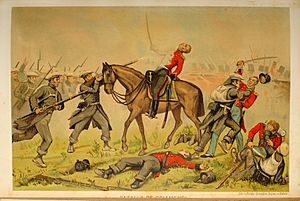Battle of Oriamendi facts for kids
Quick facts for kids Battle of Oriamendi |
|||||||
|---|---|---|---|---|---|---|---|
| Part of First Carlist War | |||||||
 Victorious charge by the 5th Guipúzcoan Regiment |
|||||||
|
|||||||
| Belligerents | |||||||
| Commanders and leaders | |||||||
|
|||||||
| Strength | |||||||
| 9,300 (½ Spanish) | |||||||
| Casualties and losses | |||||||
| ~1,000 and 1,500 | |||||||
The Battle of Oriamendi (in Basque: Oriamendiko Gudua) was a very important fight during the First Carlist War. It happened on March 16, 1837. This battle was a huge win for the Carlists. They were one of the two main groups fighting in Spain at that time.
What Happened Before the Battle
The battle was part of a bigger plan in the spring of 1837. The "Liberal Army" wanted to push the Carlists out of the Basque Country. The First Carlist War was a fight over who should rule Spain.
General Pedro Sarsfield marched from Pamplona. His job was to threaten a mountain pass called Lecumferri. At the same time, General Espartero moved from Bilbao. His goal was to distract the Carlist forces.
A combined British and Spanish force also joined the attack. They started from San Sebastián. This group was led by George de Lacy Evans. They planned to attack Hernani, which the Carlists controlled. General Sarsfield designed this plan. He hoped to completely defeat the Carlist army.
On March 15, the British Auxiliary Legion captured a fort. It was called Oriamendi and was on a key hill near San Sebastián. Carlist soldiers from Guipuzcoa had been defending this hill.
The Battle Itself
The very next day, the Carlists fought back. Their leader was Sebastian de Borbón. They launched a strong counterattack. The Carlists defeated the Liberal forces and the British Legion. Both sides suffered many losses.
Because of this battle, the British-Liberal army had to retreat. They went back to their safe trenches outside San Sebastian. This army lost between 1,000 and 1,500 soldiers. Luckily, the Royal Navy fired cannons from their ships. This covering fire stopped the retreat from becoming a complete disaster. The Carlist troops won because they used a clever defense strategy. They also had very fast-moving foot soldiers.
What Happened After the Battle
After their big win, the Carlists surrounded San Sebastián even more tightly. However, they never managed to capture the city.
The defeat made many people in the British parliament very angry. But for the Carlists, this battle was a huge boost to their spirits. The victory is still remembered in the Marcha de Oriamendi. This song became the official anthem of the Carlist movement.
See also
 In Spanish: Batalla de Oriamendi para niños
In Spanish: Batalla de Oriamendi para niños
- Battle of Andoain
- Oliver de Lancey
- Maurice O'Connell



